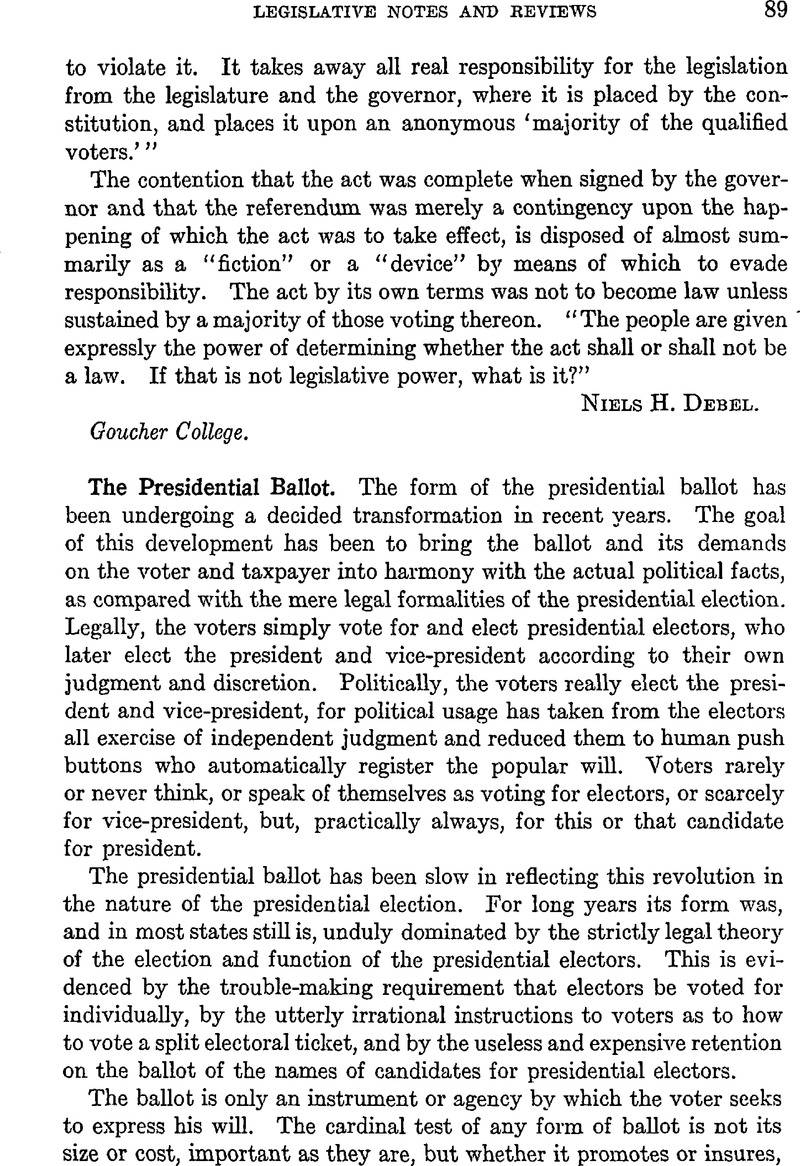No CrossRef data available.
Published online by Cambridge University Press: 01 August 2014

1 In Arkansas the voter votes negatively by marking out the names of the candidates he does not favor.
2 Arkansas, Colorado, Florida, Mississippi, Montana, Nevada, New Jersey, Oregon, Tennessee, Wyoming.
3 Nine Democrats, nine Republicans, one Socialist.
4 One was the candidate of two parties.
5 Of the last eleven elections only four have been free from divided electoral votes, of which there were eleven in all in seven different states, not counting the Michigan division of 1892 due to choosing electors by districts.
6 South Carolina has a separate national ballot for electors, senators and congressmen.
7 Alabama, Connecticut, Delaware, Georgia, Idaho, Illinois, Indiana, Kentucky, Louisiana, Michigan, Missouri, New Mexico, Oklahoma, South Carolina, South Dakota, Texas, Utah, Washington, West Virginia.
8 California, Maine, Maryland, New Jersey, New York, North Carolina, Ohio, Pennsylvania, Vermont, Wisconsin.
9 Laws, 1921, ch. 81, p. 74.
10 Maine, New York, North Carolina, Ohio, Vermont, Wisconsin. In Maine due primarily, no doubt, to the practice of choosing all other national and state officers in September.
11 Note the divided electoral vote in states having this type. California in 1880, 1892, 1896 and 1912; in Maryland in 1904 and 1908; in Ohio in 1892.
12 In Virginia each group of electors is topped by the names of the party candidates for president and vice-president, and the voter votes negatively for a group of electors by scratching the names of the presidential and vice-presidential candidates he does not favor.
13 Colorado, Georgia, Illinois, Kansas, Louisiana, Maine, Maryland, Massachusetts, Missouri, Nevada, New Hampshire, New Jersey, New York, Ohio, Oregon, Pennsylvania, Rhode Island, Tennessee, Utah, Vermont, Virginia, West Virginia, Wisconsin.
14 Arizona, Minnesota, North Dakota.
15 In Alabama and Oklahoma the names of the electoral candidates come after those of congressional and state officers. There is doubt regarding Mississippi and Tennessee.
16 Colorado, Delaware, Illinois, Indiana, Iowa, Michigan, Minnesota, Nebraska Ohio, Virginia, Washington, West Virginia.
17 Notably Maine, New York, Vermont, and Wisconsin despite their having separate presidential ballots. However such instructions logically accompany an opportunity to vote for individual electors.
18 North Dakota's three electoral votes were divided among three candidates, while Oregon gave three of her four to one candidate and one to another.
19 Iowa has the party column party circle ballot; Nebraska, the modified office group ballot, with candidates grouped under offices, but with the addition of a party circle for voting a straight ticket.
20 Laws of Nebraska 1917, ch. 33, Sec. 1.
21 Cf. Sikes: “A step toward the Short Ballot” in National Municipal Review, September 1922, pp. 260–262, where the writer makes the serious error of stating repeatedly that Iowa provides for the appointment of electors by the governor.
22 Laws of Iowa General Assembly, 1919, ch. 86, Sec. 6.
23 The divided vote of West Virginia in 1916 was caused by such a resignation.
24 House bill No. 50.
25 Governor's veto messages, 1921, p. 6.
26 Sikes, op. cit. p. 262.
27 U. S. Constitution Art. II, sec. 1, Sub-sec. 2.
28 Ibid., Sub-sec. 4.
29 Ibid., Arts. XV and XIX.
30 U. S. Compiled Statutes, Title III, sec. 199.
31 In 1920 the presidential election fell on November 2, and the Nebraska electors were appointed by the governor on November 27.
Comments
No Comments have been published for this article.